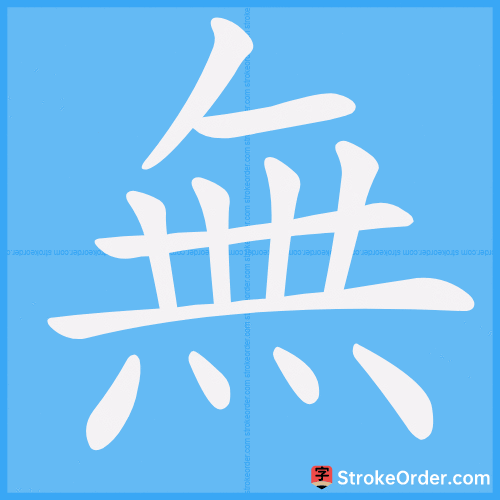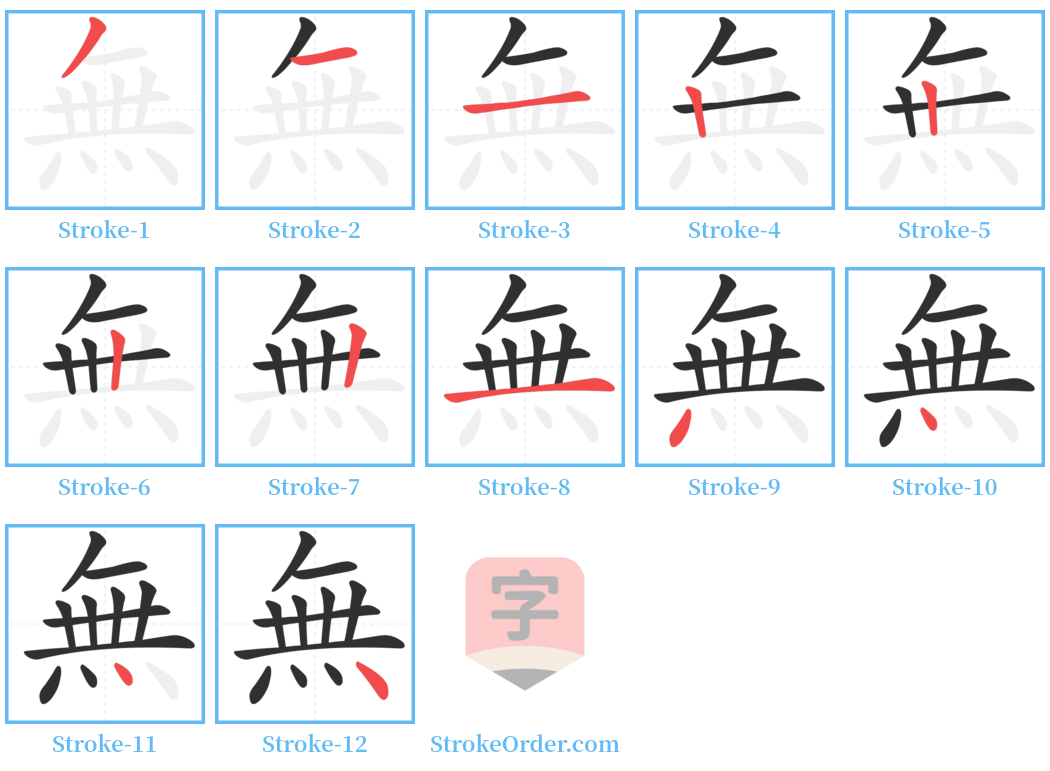無 Stroke Order
Animated Stroke Order of 無

Stroke Order Diagrams for 無

Step-by-Step Handwriting Guide for 無

Learn to Write Chinese Characters with Video Tutorials
Watch the video of writing the Chinese character "無", learn the correct stroke order (笔顺) of the character "無", and master the standard way of writing the character "無".
Free Printable Handwriting Practice with Stroke Order: 無
Printable Writing Practice Worksheet of "無" in Portrait Orientation (Tian Zi Ge)

Printable Writing Practice Worksheet of "無" in Landscape Orientation (Tian Zi Ge)

Information of 無
Pinyin
wú、 mó
Radical
灬
Strokes
12 strokes
Usage
★★★
Definition
-less / not to have / no / none / not / to lack / un-
无
1. **没有**, 直对“有”。
**Not have**, the opposite of "have".
2. **哲学概念**。指无形、无名、虚无等,或指物质的隐微状态。
**Philosophical concept**. Refers to the formless, nameless, nothingness, etc., or to the subtle state of matter.
3. **间隙**。
**Gap**.
4. **非,不是**。
**Not**.
5. **荒芜**。后作“蕪”。
**Desolate**. Later written as "蕪".
6. **代词**。表示不定指的人、事物、时间、处所等,相当于“没有哪个”、“没有法子”。
**Pronoun**. Indicates an indefinite reference to people, things, time, places, etc., equivalent to "there is no one" or "there's no way".
7. **副词**。
1. 表示否定。相当于“不”。
**Adverb**. 1. Indicates negation. Equivalent to "not".
2. 相当于“未”。
3. 表示反诘,相当于“得无”。
4. 表示疑问,用在句尾,相当于“不”、“没”。
8. **连词**。表示条件关系,相当于“无论”、“不论”。
**Conjunction**. Indicates conditional relations, equivalent to "regardless" or "no matter".
9. **助词**。用于句首。
**Particle**. Used at the beginning of a sentence.
10. **“毋”**。副词。不要。
**"毋"**. Adverb. Do not.
11. **通“幠(hū)”**。覆盖。
**Same as "幠 (hū)"**. To cover.
12. **姓**。
**Surname**.
无 wú
1. **本义**: 乐舞
**Original Meaning**: Singing and dancing
2. **哲学范围**,指无形、无名、虚无等,或指物质的隐微状态。
**Philosophical scope**, refers to formlessness, namelessness, nothingness, etc., or to the subtle state of matter.
无 wú (verb)
没有,跟“有”相对。
Not have; there is not.
无 wú (adverb)
1. 不,表示对动词或形容词的否定。
Not, indicating the negation of a verb or adjective.
2. 通“毋”,表示劝阻或禁止,可译为“不要”、“别”。
Same as "毋", indicating prohibition or advising against something, can be translated as "do not" or "don't".
3. 未,不曾,没。
No, not.
4. 不必,不值得。
Need not; not worth.
无 wú (pronoun)
表示不定指的人、事物、时间、处所等。
Indicates an indefinite reference to people, things, time, places, etc.
无 wú (conjunction)
连接词组或分句,表示在任何条件或情况下一样,相当于“不论”、“无论”。
Connects phrases or clauses, indicating that it is the same under any conditions or situations, equivalent to "regardless".
无 wú (sentence initial or final)
用在句首,表示无义; 用在句末,表示疑问语气,可译为“吗”。
Used at the beginning of a sentence, indicating no meaning; used at the end of a sentence, indicating a questioning tone, can be translated as "is it?"
无 máo
1. 南无。
1. Namo: A term used in Buddhism to show respect or to seek refuge to the Buddha.
2. 另见 wú。
Also see wú.